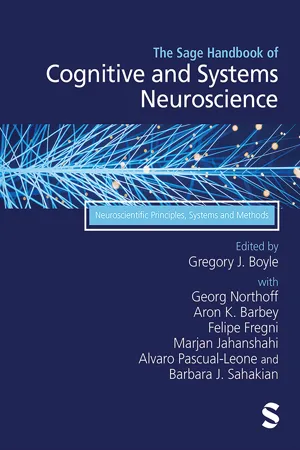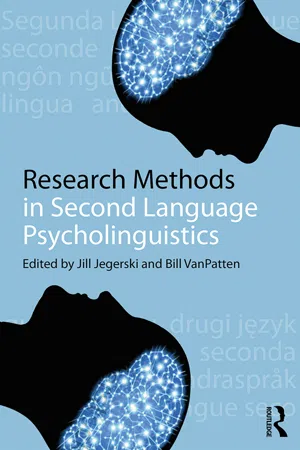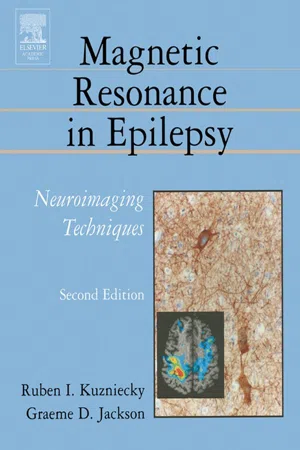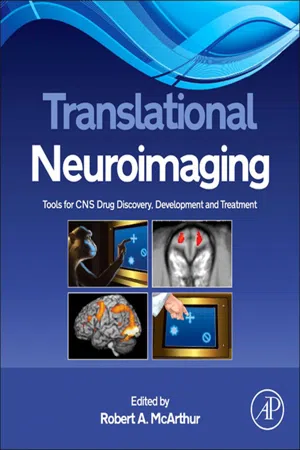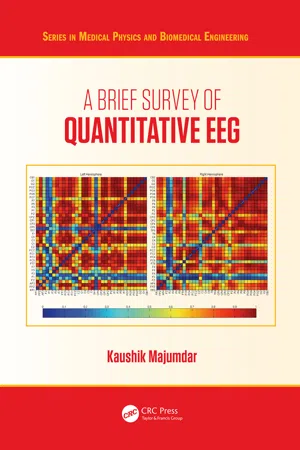Psychology
Functional Magnetic Resonance
Functional Magnetic Resonance Imaging (fMRI) is a neuroimaging technique that measures brain activity by detecting changes in blood flow. It is commonly used in psychology to study cognitive processes, emotions, and behavior. By providing detailed images of brain function, fMRI helps researchers understand how different regions of the brain are involved in various mental processes.
Written by Perlego with AI-assistance
Related key terms
11 Key excerpts on "Functional Magnetic Resonance"
- eBook - ePub
Advanced MR Neuroimaging
From Theory to Clinical Practice
- Ioannis Tsougos(Author)
- 2017(Publication Date)
- CRC Press(Publisher)
7 Functional Magnetic Resonance Imaging (fMRI) 7.1 Introduction Focus Point • Indirect measurement of neural activity, based on hemodynamic changes. • Oxyhemoglobin is diamagnetic, while deoxyhemoglobin is paramagnetic. • Following neuronal activity, there is an increase of oxygenated blood delivery, increasing oxyhemoglobin, therefore increasing the MR signal. • Paradigm design for fMRI is challenging. • Temporal resolution is limited by hemodynamic response. • Need for cooperative patients. • High magnetic fields (≥3 T) are preferable. • Resting state fMRI is a recent concept. 7.1.1 What Is Functional Magnetic Resonance Imaging (fMRI) of the Brain? Functional Magnetic Resonance imaging (fMRI) is a neuroimaging procedure performed in the MRI scanner to evaluate functional brain activity, basically by detecting changes associated with blood flow during specific stimuli. In that sense, the term “functional” may be considered misleading since the procedure actually provides an indirect measurement of neural activity, relying on the fact that cerebral blood flow and neuronal activation may be linked. Although fMRI is indeed one of the most recently applied methods of neuroimaging, the basic idea behind the technique is quite old. That is, if brain activity requires blood flow, it may be possible to estimate it by measuring changes in blood flow. Interestingly, William James in The Principles of Psychology, a monumental text in the history of psychology published in 1890, mentioned an Italian scientist named Angelo Mosso who performed an experiment in the late 1800s by observing the patient on a delicately balanced table, which could tip downward either at the head or the foot if the weight of either end was increased. Theoretically, any emotional or intellectual activity of the subject would redistribute the blood flow and change the table’s balance - eBook - ePub
- P. Michael Conn(Author)
- 2009(Publication Date)
- Academic Press(Publisher)
II. IntroductionThe rapid development of methods for noninvasive brain mapping, particularly over the past decade, has led to exciting advances in our understanding of the human brain. Foremost in these methodologies is the technique of Functional Magnetic Resonance imaging (fMRI). Utilizing the intrinsic magnetic properties of the blood, it is possible to identify the brain region associated with a specific sensory, motor, or even cognitive task to a high spatial precision. Unlike positron emission tomography (PET), MRI does not use radioactively labeled compounds and is essentially noninvasive and safe for repeat studies. Although fMRI does not share the temporal resolution of electroencephalography (EEG) or magnetoencephalography (MEG), it does have a spatial resolution of millimeters, and the most recent experiments suggest that it may be able to detect activations at the level of the cortical layers (Silva and Koretsky, 2002 ).While fMRI is a complex methodology, developments in recent years, particularly by the scanner manufacturers and other commercial and academic groups, have meant that the tools for fMRI, while expensive, are more commonly available. In particular, the available software for both fMRI stimulus presentation and image analysis are highly sophisticated and user-friendly. This means that human fMRI is now achievable by research groups without dedicated physics and image analysis support.III. Experimental Procedures A. Overview of Methods - eBook - ePub
The Sage Handbook of Cognitive and Systems Neuroscience
Neuroscientific Principles, Systems and Methods
- Gregory J. Boyle, Georg Northoff, Aron K. Barbey, Felipe Fregni, Marjan Jahanshahi, Alvaro Pascual-Leone, Barbara J. Sahakian, Gregory J. Boyle, Georg Northoff, Aron K. Barbey, Felipe Fregni, Marjan Jahanshahi, Alvaro Pascual-Leone, Barbara J. Sahakian(Authors)
- 2023(Publication Date)
- SAGE Publications Ltd(Publisher)
At the most basic level, consciousness can be viewed as the result of billions of neurons firing rapidly. While non-invasive in-vivo measurement of individual neuron activity remains a vision of the future, current neuroimaging methods provide increasingly powerful non-invasive methods for inferring brain function of neuronal populations through various modalities, the most prevalent being fMRI, MEG, and PET. Crucially, each method records brain activity in a fundamentally different manner, resulting in unique strengths and weaknesses for inferring underlying brain function.Functional Magnetic Resonance Imaging (fMRI)
Functional Magnetic Resonance Imaging (fMRI) is a measure of blood oxygenation level-dependent (BOLD) contrast of the brain's microvasculature. Hemoglobin in blood is the body's primary oxygen-transport for sustaining metabolic function. The release of oxygen results in the formation of deoxyhemoglobin, a paramagnetic molecule that provides a naturally occurring BOLD contrast which can be accentuated through application of gradient-echo MR sequences. The seminal paper by Ogawa et al. (1990) demonstrated that the BOLD contrast can be used to generate real-time maps that reflects induced physiological changes associated with metabolic demand and blood flow. Using a standard 3 Tesla (3T) MRI scanner, fMRI allows for very high spatial resolution (∼1-2mm) and signal depth, allowing activity to be recorded from all cortical and subcortical regions of the brain. This can be further enhanced to sub-millimeter spatial resolution when scanning at ultra-high field strengths of 7T and above (Kemper et al., 2018). Change in blood oxygenation is, however, a relatively slow biological process, thus the temporal resolution of fMRI is typically limited to differentiating changes in brain activity around one second or more apart.Figure 32.1 - Jill Jegerski, Bill VanPatten(Authors)
- 2013(Publication Date)
- Routledge(Publisher)
Functional Magnetic Resonance Imaging (fMRI) Aaron J. NewmanHistory of the Method
Functional Magnetic Resonance imaging (fMRI) celebrated its twentieth birthday in 2012 (Kwong et al., 1992; Ogawa et al., 1992). In this time, it has become the most widely-used technique for noninvasively investigating human brain activity in vivo.1 The first publications showing noninvasive measurement of human brain activity were preceded by more than 100 years of observation and research. In 1890, the physiologists Roy and Sherrington demonstrated that brain volume increased when the peripheral nerves of animals were electrically stimulated, leading them to posit “… the existence of an automatic mechanism by which the blood-supply of any part of the cerebral tissue is varied in accordance with the activity of the chemical changes which underlie the functional action of that part” (Roy & Sherrington, 1890, p. 105). Another key observation was published by Pauling and Coryell in 1936—that hemoglobin, the molecule in our blood that transports oxygen, has different magnetic properties depending on whether it is bound to oxygen (oxyhemoglobin—Hb) or not (deoxyhemoglobin—dHb). Hb is magnetically neutral, while dHb is paramagnetic , meaning that it has weak magnetic properties and will be attracted to a magnetic field. Work in chemistry and physics led to the development of the nuclear magnetic resonance (NMR) technique in the 1970s, which led soon after to the MRI, which uses strong magnetic fields, for in vivo medical imaging. Ogawa, Lee, Kay, and Tank (1990) published work showing that a particular type ofMRI image, called T2*-weighted, was sensitive to the amount of oxygen in the brain. Blood vessels in the brains of rats that were breathing room air appeared much darker in the MRI images than when the rats were breathing pure oxygen. This provided a potential intrinsic contrast- eBook - ePub
Magnetic Resonance in Epilepsy
Neuroimaging Techniques, Second Edition
- Ruben Kuzniecky, Graeme D. Jackson(Authors)
- 2005(Publication Date)
- Academic Press(Publisher)
CHAPTER 10Functional MRI in Epilepsy
Jeffrey R. Binder and John A. DetreINTRODUCTION
The goal of functional neuroimaging is to map the activity of the living brain in space and time. Electrophysiologic methods such as magnetoencephalography and electroencephalography offer direct measurements of neural activity with high temporal resolution but are limited by difficulties in defining the spatial location and extent of activation. Neuroimaging methods based on metabolic and vascular parameters, while offering limited temporal resolution, provide excellent spatial resolution and localization of brain function. One such method, Functional Magnetic Resonance imaging (fMRI), enables completely noninvasive imaging of changes in blood oxygenation and perfusion. In recent years fMRI has become the most widely used modality for visualizing regional brain activation and is beginning to find widespread application in clinical neuroscience.Unlike positron emission tomography (PET), fMRI does not require exposure to ionizing radiation. fMRI can thus be performed many times in the same subject without additional health risks, providing improved statistical power, measures of test–retest reliability, the ability to monitor changes in activation serially over time, and the potential for exploring a wide range of activation tasks. Compared to PET, fMRI provides superior temporal and spatial resolution and increased sensitivity for detecting task activation in individual subjects through signal averaging. On the other hand, PET provides a greater repertoire of image contrast sources. Whereas fMRI is primarily sensitive to hemodynamic changes, PET images can reflect blood flow, glucose utilization, oxygen consumption, and receptor binding. The latter occurs at concentrations well below the sensitivity of MRI, and can only be measured in vivo with radioactive tracers, although fMRI can be used to visualize pharmacological effects indirectly (1 –3 - eBook - ePub
- (Author)
- 2011(Publication Date)
- Academic Press(Publisher)
This chapter reviews the key contributions of Functional Magnetic Resonance imaging (fMRI) to our understanding of human cognition and its various disorders. Following a brief introduction on fMRI methodology, the application of fMRI to elucidate the neural mechanisms underlying some core aspects of human cognition (language, praxis, spatial cognition, memory) is illustrated. The convergence (and divergence) of functional imaging and neurological data from patients with lesions of the central nervous system is then reviewed. Special emphasis is placed on how this informs our knowledge of the pathophysiology of disorders of cognition and neurological disease before the use of robust fMRI paradigms in presurgical patient evaluation and the planning of neurosurgical approaches to, for example, brain tumors (i.e., neuronavigation) is illustrated. Thereafter, the application of fMRI in developing novel approaches to the treatment of patients with neurological and neuropsychological deficits is highlighted. The chapter demonstrates the powerful potential of applying fMRI in both a clinical and a more research-oriented environment and its promising perspective to deliver new insights into neurological diseases and their treatment in the years to come. The chapter finishes by highlighting two particularly promising areas: human pharmacological fMRI and studies that link genotypic and phenotypic information. These intriguing new research avenues allow mapping of modulatory effects of pharmacological agents on large-scale neural systems supporting cognitive functions. The data enable inferences with reference to pharmacodynamics, specific neurotransmitters supporting specific cognitive operations, and most recently, changes in neurophysiological drug effects associated with genetic variations.Functional imaging of the human brain today is largely using fMRI because 1.5 or 3 tesla (T) MRI scanners are universally available. Furthermore, the techniques for determining which parts of the brain are activated (e.g., when moving a finger or making a decision) are easy to implement in a standard clinical environment. Human “brain mapping” is achieved by setting up the MRI scanner in a way that it detects changes in the regional distribution of blood flow to tissue with higher oxygen demand due to increased neural activity. There are different methods to achieve this; the most common technique uses the blood oxygenation level-dependent (BOLD) effect [1 - eBook - ePub
Translational Neuroimaging
Tools for CNS Drug Discovery, Development and Treatment
- Robert A. McArthur(Author)
- 2012(Publication Date)
- Academic Press(Publisher)
social brain ). We then discuss the use of these regions, and their dysfunction, in the diagnosis of ASD. We conclude with a discussion of endophenotypes, characteristics (e.g. behavioral, neuropsychological, and physiological) that reflect the genetic liability for a class of diseases that exists midstream between genotype and clinical phenotype and may be measurable both in affected and unaffected individuals.1.0 What is fMRI?
Brain imaging has evolved into one of the main translational tools for the study of central nervous system function, its various psychiatric and neurologic pathologies, and for the discovery and development of novel drugs that can be used to address these pathologies. Functional Magnetic Resonance imaging (fMRI), with its excellent spatial resolution and ability to visualize networks of neuroanatomical structures involved in complex information-processing functions, has become the dominant technique for the study of brain function in autistic spectrum disorders (ASD). fMRI requires a magnetic resonance imaging scanner, a high rate of image acquisition, and specialized pulse sequences to measure localized brain activity, which takes advantage of the endogenous blood oxygen level dependent (BOLD) contrast, i.e. the MRI contrast of blood deoxyhemoglobin, to image brain activity. To its benefit, this technique does not depend on ionizing radiation and does not require any sort of invasive procedure. Ogawa and colleagues1 first discovered this intrinsic contrast mechanism. Because neurons do not store internal reserves of glucose and oxygen, both of which are essential for their proper function, an increase in neuronal activity, typically in response to a demand for information processing, requires the immediate delivery of glucose and oxygen via the bloodstream. As a result, elevated levels of oxyhemoglobin occur in active areas, giving rise to a measureable change in the surrounding ratio of oxy- to deoxyhemoglobin, which provides a localizable proxy for brain activity detectable by MRI.i - eBook - ePub
Biophysical Measurement in Experimental Social Science Research
Theory and Practice
- Gigi Foster(Author)
- 2019(Publication Date)
- Academic Press(Publisher)
Chapter 3fMRI in Economics: What Functional Imaging of the Brain Can Add to Behavioral Economics Experiments
Niree Kodaverdian Pomona College, Claremont, CA, United StatesAbstract
Being the study of individuals’ and society’s choices in the face of scarcity, economics is invariably concerned with the human decision-making process. As decision making can occur under different circumstances, such as under risk, across time, or in social contexts, different theories exist to describe and to predict people’s decisions. Alternate theories have been proposed within each context, based on field and experimental observations of human behavior. Functional Magnetic Resonance imaging (fMRI) technology has provided economists with an unmatched ability to test individual theories, and to resolve competing theories. In this chapter, I first outline economic theories relevant to fMRI technology, briefly describe what is meant by “brain activity” and explain how fMRI technology works in illuminating this activity. Then, I summarize findings from neuroeconomics experiments involving decisions in the different contexts introduced. I conclude the chapter by noting some limitations of using fMRI in experiments.Keywords
Behavioral economics; Neuroeconomics; Neuroscience; Experiments; Brain imaging; fMRIIntroduction
Among the best known biophysical measurement methods is Functional Magnetic Resonance imaging (fMRI). Since the introduction of the magnetic resonance imaging (MRI) machine in health care in the 1980s, MRI has provided doctors with an unparalleled look into the body, beyond the possibilities available with other imaging techniques, such as X-ray radiography, ultrasonography, or computed tomography (CT). About a decade after its introduction to the clinic, seminal papers by researchers at Bell Laboratories and the Martinos Center introduced to the world a new use for the MRI machine: fMRI (Belliveau et al., 1991 ; Kwong et al., 1992 ; Ogawa, Lee, Nayak, & Glynn, 1990 - eBook - ePub
Biosignal Processing
Principles and Practices
- Hualou Liang, Joseph D. Bronzino, Donald R. Peterson(Authors)
- 2012(Publication Date)
- CRC Press(Publisher)
6Functional Optical Brain Imaging
Meltem Izzetoglu Drexel University6.1Introduction6.2Working PrinciplesPhysiological Principles: How Can Brain Activity Be Measured through Hemodynamic Changes? • Physical Principles: How Can Hemodynamic Activity Be Measured by Optics?6.3Instrumentation6.4fNIR MeasurementsFast Neuronal Signal • Slow Hemodynamic Signal6.5fNIR Signal ProcessingSignal Separation and Noise Removal • Hemodynamic Signal Extraction from fNIR Intensity Measurements6.6fNIR StudiesSummary of Basic Research and Clinical Application Studies • Specific Example Studies • Studies Involving Complex Tasks, Field, and Clinical Applications • Future DirectionsAcknowledgments References6.7Conclusion6.1IntroductionFunctional imaging is typically conducted in an effort to understand the activity in a given brain region in terms of its relationship to a particular behavioral state, or its interactions with inputs from another region’s activity. The advances in noninvasive functional brain monitoring technologies provide opportunities to accurately examine the living brains of large groups of subjects over long periods of time, with little impact on their well-being. Neurophysiological and neuroimaging technologies have contributed much to our understanding of normative brain function, as well as to our understanding of the neural underpinnings of various neurological and psychiatric disorders. Commonly employed techniques such as electroencephalography (EEG), event-related brain potentials (ERPs), magnetoencephalography (MEG), positron emission tomography (PET), single-positron emission computed tomography (SPECT), and Functional Magnetic Resonance imaging (fMRI), have dramatically increased our understanding of a broad range of brain disorders. Nevertheless, there is still much unknown about these syndromes. This is due, in large part, to the inherent complexity of the neurobiological substrates of these disorders and of the mind itself. In addition, each of the research methods used to study brain function and its disorders have methodological strengths as well as their own inherent limitations. These limitations place constraints on our ability to fully explicate the neural basis of neurological and psychiatric disorders both inside and outside of the laboratory setting, and to use the information gleaned from laboratory studies for clinical applications in real-world environments. New techniques that allow data to be gathered under more diverse circumstances than is possible with extant neuroimaging systems should facilitate a more thorough understanding of brain function and its pathologies. - eBook - ePub
- Clement Hamani, Paul Holtzheimer, Andres M. Lozano, Helen Mayberg, Clement Hamani, Paul Holtzheimer, Andres M. Lozano, Helen Mayberg(Authors)
- 2015(Publication Date)
- Wiley-Blackwell(Publisher)
The field of psychiatry has undergone a transformation over the last 50 years with major research efforts now focused on treatments based on neurobiology. Pharmacotherapy has been based on knowledge of neurotransmitter systems, with relatively less emphasis on neuroanatomy. However, other treatments that target the brain, such as deep brain stimulation (DBS) and transcranial magnetic stimulation (TMS), rely on detailed knowledge of brain structure, function and connectivity. Although much has been learned about basic brain function and structure from animal models, human neuroimaging plays a crucial role in establishing the neural circuitry unique to human psychiatric conditions. The last decade has seen an explosion of neuroimaging research and has provided insight into the mechanisms underlying many psychiatric conditions. These advancements not only hold promise for developing more effective therapeutic strategies but have already begun to provide some beneficial therapies. Furthermore, studies of psychiatric conditions using structural and functional neuroimaging should firmly dispel any doubts that psychiatric conditions have their underpinnings in ‘real’ abnormalities of brain structure and function. The traditional division between neurological and psychiatric illness thus becomes more blurred, or at least defined more concretely in terms of differing neuroanatomical substrates. This chapter will focus on magnetic resonance imaging (MRI)-based techniques (see Ref. 1) and their applications to three brain stimulation modalities: transcranial direct current stimulation (tDCS), repetitive transcranial magnetic stimulation (rTMS) and DBS.What can MRI offer the field of psychiatry?
Crucial to any treatment that targets the brain is the understanding of brain pathology specific to a disorder. This knowledge can then guide therapeutic target selection in terms of brain location and type of therapy (e.g. to excite versus to inhibit). Mental illness is assumed to reflect dysfunction of the operations of specific brain regions and/or brain circuits. Such dysfunction could include hypo-, hyper- or aberrant activity in neurons, pathways or circuits. These functional abnormalities may reflect or drive structural deficits of brain connections and/or the grey matter within involved brain regions. Modern MRI-based techniques can be used to locate and evaluate brain abnormalities associated with psychiatric conditions. The following is an overview of the structural and functional MRI (fMRI) techniques currently being used for this purpose.MRI measures of grey matter
There are now well-established structural MRI methods based on T1-weighted images to measure the amount of grey matter in the brain. The most popular methods are voxel-based morphometry (VBM) [2] and cortical thickness analysis (CTA) [3]. Of these two methods, VBM is by far the most commonly used. VBM involves classifying each voxel in the brain as grey matter, white matter or cerebrospinal fluid (CSF) based on its signal intensity and thereby determining grey matter volumes of structures throughout the brain. The greatest utility of VBM is for evaluation of subcortical structures. However, grey matter values obtained with VBM are relative values and not study specific, and so cannot directly be compared across studies and laboratories. Also, cortical folding complexities are not specifically considered. The approach of CTA overcomes these two limitations. In CTA, after segmenting the brain into grey matter, white matter and CSF, the pial-grey matter border and the grey /white matter border surfaces are determined. This is then used to measure the cortical thickness at each point and thus determine scalar values of cortical thickness. The advantage of CTA is that it outputs scalar values of thickness that can be compared across studies. However, CTA cannot evaluate subcortical grey matter and so it is considered a complementary method to VBM for grey matter investigations. Many studies have compared the two methods highlighting their relative utility and also factors that should be considered for clinical studies (e.g. age, sex and disease progression) [4, 5]. - eBook - ePub
- Kaushik Majumdar(Author)
- 2017(Publication Date)
- CRC Press(Publisher)
There is little activation of neurons, blood flow is not increased, and a relatively large proportion of hemoglobin is in the deoxygenated form. Because deoxygenated hemoglobin promotes efficient dephasing of the rotating protons, the T 2 * curve that characterizes fMRI is relatively steep (Figure 8.18), and the magnetic resonance signal is weak. This contrast in T 2 * -weighted imaging between the activated and inactivated regions of the brain gives rise to the BOLD fMRI images (Figure 8.18) of functional activation of the brain. FIGURE 8.18 The region of the brain that is stimulated (active) (b) demands more oxygen than the one that is not stimulated (inactive) (a) and therefore has a greater concentration of oxyhemoglobin (b). Phase dispersion in the region will vary accordingly (middle left) leading to differential T 2 ∗ decay time (middle right). fMRI (c) is generated by exploiting this difference in decay time. (Taken from Kandel, E.R. et al. (eds.), Principles of Neural Science, 4th ed., McGraw Hill, New York, 2000.) 8.4 Interpreting the BOLD Response According to the neural doctrine the activity of the brain is due to firing of the neurons. The question is how far these neuronal activities are captured in the BOLD fMRI response. Neuronal firing gives rise to brain electrophysiological signals at different scales. The most fundamental of them are the neuronal spike trains, that is, trains of action potentials fired by one single neuron. These spike trains in turn produce a postsynaptic potential at the output synapses of the neuron. In Chapter 1 we have seen how these postsynaptic potentials travel through layered tissues to give rise to the scalp EEG. Also, when these postsynaptic potentials are collected from the surface of the cortex by touching intracranial electrode tips on it, that is called an electrocorticogram or ECoG. There is yet another kind of brain electrical signal known as the local field potential or LFP
Index pages curate the most relevant extracts from our library of academic textbooks. They’ve been created using an in-house natural language model (NLM), each adding context and meaning to key research topics.


